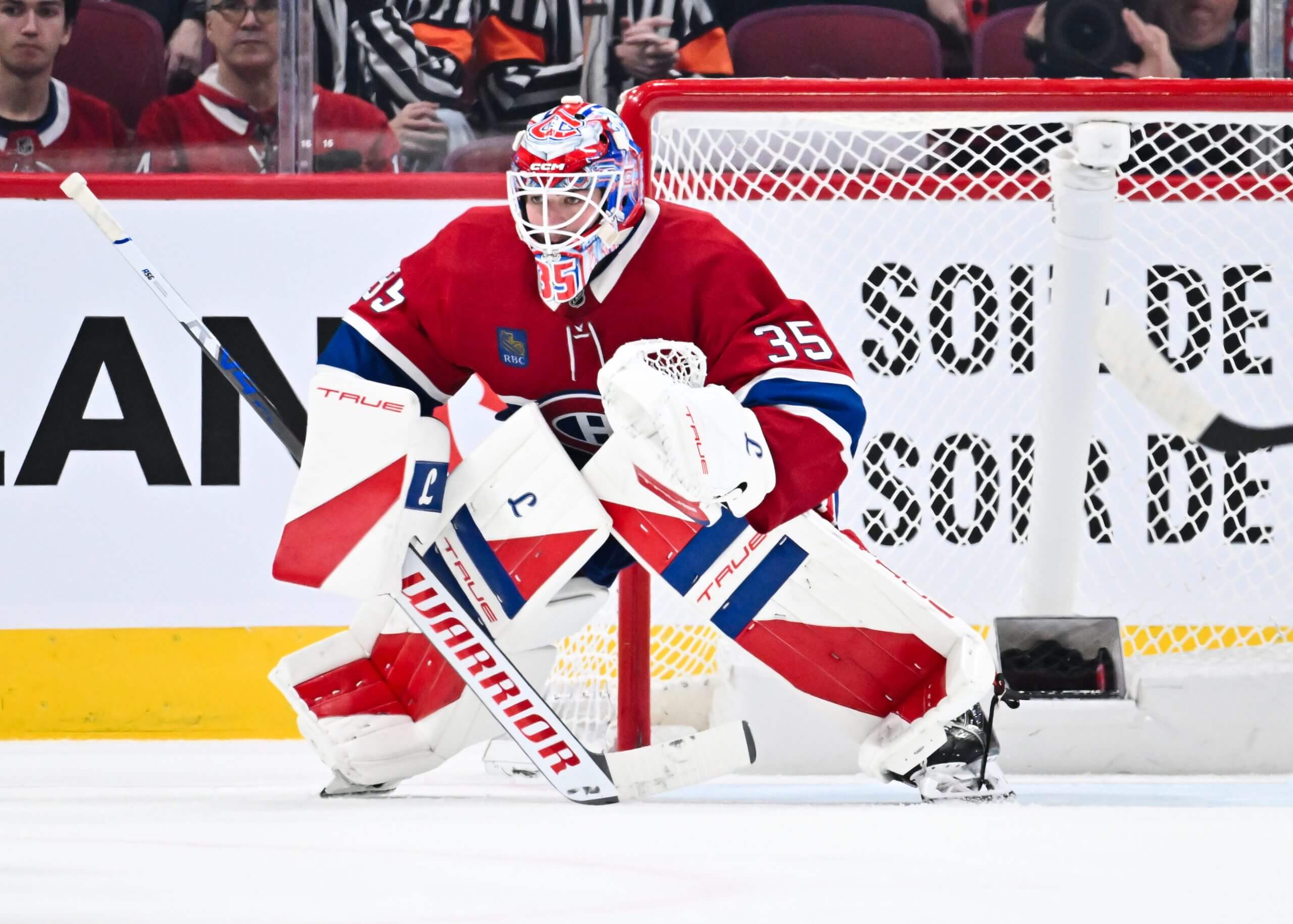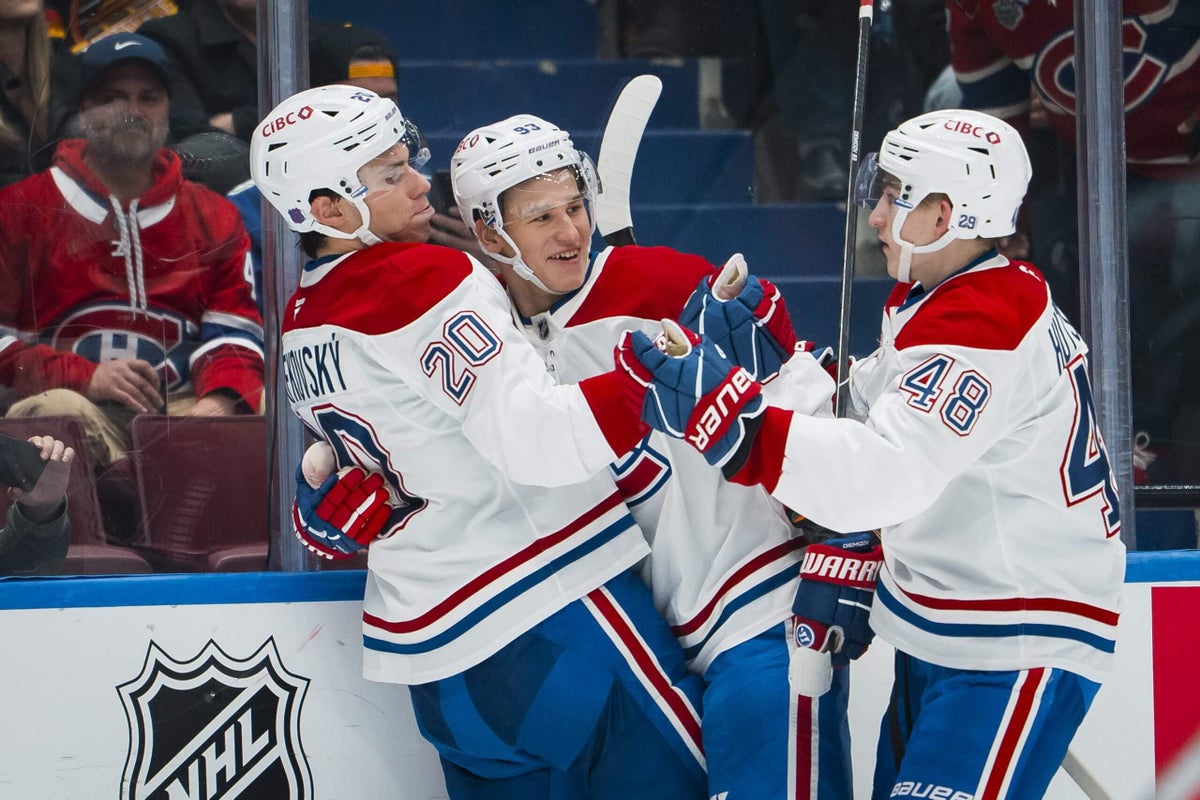SEATTLE – Ivan Demidov was asked after the Montreal Canadiens’ 4-3 win against the Vancouver Canucks on Saturday how he uses his eyes as a weapon, as a tool to confuse defenders and open up seams to exploit.
English is Demidov’s second language, and although he is able to communicate very well, he sometimes struggles to get the ideas in his mind to come out properly from his mouth. Which is basically the opposite of how he plays hockey, because his ability to convert what he sees into actions he executes with his hands and feet is remarkable for a 19-year-old kid playing in the best hockey league in the world.
The process is seamless. It happens in an instant. It has deception baked in from the start.
And it is special.
“He’s a playmaker — he goes out and makes plays,” Canadiens captain Nick Suzuki said. “When you can give a defender a read and go the other way, it’s tough for them. They get their sticks in different positions. It’s tough when PKs don’t know where you’re going and you’re looking one way and he goes the other way. It’s a special talent. It’s nice to see a young guy have it really early.”
But when it comes to answering questions about how he plays hockey, Demidov still struggles a bit.
“I don’t know, it’s hard to say,” Demidov said. “Just try to maybe sometimes fake or something. I don’t know.”
But then he summed up that ability perfectly.
“Sometimes,” he said, “I just go off my instincts.”
Yes, those instincts are what make Demidov special and what has his teammates and coach so impressed with what he can do on a sheet of ice.
And what has already become abundantly clear is how well Demidov can use his eyes as a weapon. Because if you are his teammate, and he has the puck on his stick and he is looking at you, you can basically assume he is not passing it to you — he’s using you as a decoy.
“He’s able to sell something to open something else,” Canadiens coach Martin St. Louis said. “And the guys know that and they’re ready.”
Thursday night in Edmonton was Demidov’s official debut on the Canadiens’ top power-play unit, but it was Saturday night in Vancouver that his deception on the power play was on full display. The shot fake before feeding Suzuki for the Canadiens’ opening goal was a perfect example.
SPOOKY SUZUKI 👻#GoHabsGo pic.twitter.com/FSZ6uvM3Vj
— Canadiens Montréal (@CanadiensMTL) October 26, 2025
“He knows where they are, it’s not even no-look,” Suzuki said. “He’s just able to see in his peripherals or knows where guys are going to be. Yeah, you’ve definitely got to be ready when he has the puck.”
“I think his ability to kind of threaten shots and passes and open up seams, it’s pretty special,” added Lane Hutson, who is adept at doing the exact same thing. “It helps me, it helps Suzy and everyone on that unit to kind of get into good ice. He helps us get into better space.”
This version of the Canadiens’ power play is only two games old. Demidov appears to be getting better every game. The potential here is scary.
A learning curve protecting leads
Last season, the Canadiens had a lead after two periods 26 times. They won 23 of those games, which isn’t too bad, but only three teams in the NHL entered the third period with a lead fewer times than the Canadiens. And even though the second intermission cutoff doesn’t show it, there were numerous examples last season of the Canadiens having a late-game lead only to give it away.
The Canadiens entered the third period trailing Saturday in Vancouver, but being up two goals with a little under nine minutes remaining was still a situation this team does not have a whole lot of experience being successful in, and it showed.
Shots on goal at the time Demidov gave the Canadiens a 4-2 lead were 24-24. They were 7-0 Canucks the rest of the way, and one of those shots went in on Conor Garland’s tip in front with 3:47 left in regulation and the Canucks’ goalie pulled.
“Yeah, we weren’t really used to it, to be honest with you. We weren’t up in a lot of games,” Mike Matheson, who was on the ice for all but 51 seconds of the final 4:51 on Saturday, said of last season’s issues holding late leads. “So the more we’re in that situation, the more comfortable we’ll be. That goal that they had was a nice play, that’s a tough play to defend. That’s one area that we’re going to look at for sure, but overall it was a good job.”
It was a good job only because the Canadiens held on, but this is an area of needed development for this group, to find a better balance between playing risk-free hockey with a late lead and doing nothing but defending with a late lead.
The best defence is often a good offence, and so much of what St. Louis is trying to do defensively this season is predicated on that mantra. The Canadiens didn’t do a great job of it in crunch time against the Canucks.
“I think as a young team it’s probably one part of the game we’ve got to keep working on,” St. Louis said. “I don’t think we’ve had a lot of experience in that department, and we’re hoping this year that we gain a lot of experience in that department, to be more in those situations. It wasn’t necessarily pretty, obviously we gave up one, but we found a way.
“Sometimes structure helps for sure, we’re going to keep talking about that, but to me it’s just an attitude. Attitude, to me, is more important than structure in that sense. When you have both, you raise the percentages on your side.”
The domino effect of Laine’s absence
The Canadiens announced Saturday morning that Patrik Laine will miss three to four months to recover from surgery to a core muscle injury.
St. Louis pointed out Saturday night that one of the dominoes to fall was finally putting Demidov on that top power-play unit, because without Laine on the second unit, there is less of a reason to keep Demidov there as a playmaking partner.
But at five-on-five, as unfortunate as the injury is for Laine – and let’s be clear, no one wants to see anyone undergoing surgery – it is clear the Canadiens can more fluidly roll four lines with Joe Veleno in the lineup.
Laine’s absence allowed St. Louis to move Brendan Gallagher onto the line with Jake Evans and Josh Anderson, a twosome that was simply not working with Laine but has worked tremendously with Gallagher, giving the Habs a veteran line to use in matchup situations.
They are, as St. Louis has said, the Canadiens’ “momentum line.”
The Laine-Evans-Anderson line was the Canadiens’ fourth line, but it is now Zack Bolduc, Kirby Dach and Veleno, a line that struggled in Dach’s first game back from his own injury Thursday night in Edmonton but was probably Montreal’s best at five-on-five in Vancouver.
“That was a very good game for that line,” St. Louis said. “It was a game that line needed. We were able to play a four-line game. It wasn’t the best game we played this year, but that line was very good.”
Laine’s absence is still unfortunate because he has a unique, elite skill set, but it’s difficult not to look at the Canadiens without him and see how several elements have fallen into their proper place.
Montembeault’s thought process
Sam Montembeault is not happy with the way he’s been playing. That should be clear from the outset.
Last Tuesday after practice, just before taking off on this western road trip, Montembeault was pretty frank about what’s going on.
“I know what I can do and I’ve worked a lot the last four years to grow my game,” he said. “Obviously not the best start so far, but we’re going to keep working to get to where we were at.”
There are two key issues he identified after practice Tuesday. One was as basic as it gets: his stance in the net.
“That’s what we’ve been working on, getting over there and set and try to play bigger,” Montembeault said. “I felt like during games I was shrinking a lot when guys were shooting or when I was trying to find pucks through screens. So I’m trying to work on that, trying to play bigger and work on my stance too — the most simple thing — because I feel like my hands were coming in front a bit.”
How do you work on playing bigger?
“I actually looked at myself in the glass the last practice,” he said. “Putting my blocker and my glove more outside and try to be more patient.”

Sam Montembeault has had a rough start to the season but is working on his fundamentals. (Minas Panagiotakis / Getty Images)
The other aspect is tracking. Goaltending coach Eric Raymond does this thing where he draws a box with a marker in the crease. That box is meant to make movement more efficient and help the goaltender realize he doesn’t have to cover as much space as he might think: He can cover the net by doing less, not more.
Essentially, for the puck to go in the net it has to go through that box, and that box is not nearly as big as the net.
“When he puts the box in front, if it misses that box, it’s going to miss the net,” Montembeault said, “so I don’t need to move my hands that much.”
That box is central to what Montembeault has been struggling with. His angles have been off. He is not challenging shooters enough. He needs to draw a mental image of that box in the crease during games.
The Canadiens are lucky Jakub Dobeš has been as good as he has, but they will need Montembeault to find his game for them to have any hope of success. This week offers a great opportunity for him to do that with only two games: Tuesday in Seattle and Saturday at home against the Ottawa Senators.
Flipping your stick on weak-side draws
Oliver Kapanen is on a line with Alex Newhook, so he won’t be called on to take many faceoffs on the left side of the ice. But when Newhook gets kicked out of the circle, keep an eye on Kapanen.
He will flip his right-shot stick to the other side so that he can take the faceoff as a lefty.
“It’s a great tool to have,” Kapanen said last week. “It’s just practice, when I was younger. I think that’s the way I can get power and not being weak. I think it’s been working for me.”
Kapanen feels he gets “pretty much” the same power on the left side as he does on his natural right side. It is something he has been doing since he was a kid. And he was inspired to do it from a very unlikely source.
“There was one guy in the Finnish league, Justin Azevedo, or something like that, he did that,” Kapanen said. “I was wondering, ‘What is he doing?’ I was maybe 15, maybe younger. But it pretty much started from there.”
He was much younger: just 9. Azevedo played one season in Liiga, for Lukko Rauma in 2012-13. But he left a mark on Kapanen that remains to this day.
“It just works,” he said.

